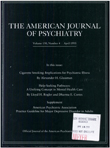Kleptomania: making sense of the nonsensical
Abstract
OBJECTIVE: Kleptomania, or the irresistible impulse to steal unneeded objects, is a poorly understood disorder. The objectives of this paper are to critically review and integrate existing data and to make suggestions for further research. DATA COLLECTION: Information was gathered by reviewing the English-language literature on kleptomania. Cases were chosen for review that approximated the diagnosis as defined in DSM-III-R. These cases were analyzed in terms of their relationship to previous theories about the disorder, and larger relevant studies were examined. Using the data organized into a table, the author explores areas of convergence and disagreement and discusses the methodological difficulties of the different studies. FINDINGS: Kleptomania is more common than previously thought. The "typical" individual with kleptomania is a 35-year-old woman who began to steal when she was 20 years old. Her thefts bring both relief and guilt. She probably has not sought treatment on her own but suffers from a necessary, pervasive, repetitive, and self-destructive act. She may have a history of sexual dysfunction or sexual preoccupation and may be unhappily married to an emotionally unsupportive husband. She has been labile and dysphoric for many years and may have a personality disorder. She has probably had a tumultuous, stressful childhood and may dissociate. CONCLUSIONS: The author proposes a biopsychosocial model of the etiology of kleptomania based on data from the literature. This model emphasizes possible childhood abuse as a precipitating factor in later development of kleptomania. More complete research is needed in the study of kleptomania.
Access content
To read the fulltext, please use one of the options below to sign in or purchase access.- Personal login
- Institutional Login
- Sign in via OpenAthens
- Register for access
-
Please login/register if you wish to pair your device and check access availability.
Not a subscriber?
PsychiatryOnline subscription options offer access to the DSM-5 library, books, journals, CME, and patient resources. This all-in-one virtual library provides psychiatrists and mental health professionals with key resources for diagnosis, treatment, research, and professional development.
Need more help? PsychiatryOnline Customer Service may be reached by emailing [email protected] or by calling 800-368-5777 (in the U.S.) or 703-907-7322 (outside the U.S.).



